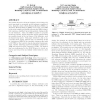Free Online Productivity Tools
i2Speak
i2Symbol
i2OCR
iTex2Img
iWeb2Print
iWeb2Shot
i2Type
iPdf2Split
iPdf2Merge
i2Bopomofo
i2Arabic
i2Style
i2Image
i2PDF
iLatex2Rtf
Sci2ools
112
Voted
DAC
2002
ACM
2002
ACM
Combined BEM/FEM substrate resistance modeling
For present-day micro-electronic designs, it is becoming ever more important to accurately model substrate coupling effects. Basically, either a Finite Element Method (FEM) or a Boundary Element Method (BEM) can be used. The FEM is the most versatile and flexible whereas the BEM is faster, but requires a stratified, layout-independent doping profile for the substrate. Thus, the BEM is unable to properly model any specific, layout-dependent doping patterns that are usually present in the top layers of the substrate, such as channel stop layers. This paper describes a way to incorporate these doping patterns into our substrate model by combining a BEM for the stratified doping profiles with a 2D FEM for the top-level, layout-dependent doping patterns, thereby achieving improved flexibility compared to BEM and improved speed compared to FEM. The method has been implemented in the SPACE layout to circuit extractor and it has been successfully verified with two other tools. Categories and ...
Boundary Element Method | DAC 2002 | Design Automation | Layout-dependent Doping Patterns | Stratified Doping Profiles |
| Added | 13 Nov 2009 |
| Updated | 13 Nov 2009 |
| Type | Conference |
| Year | 2002 |
| Where | DAC |
| Authors | Eelco Schrik, N. P. van der Meijs |
Comments (0)

